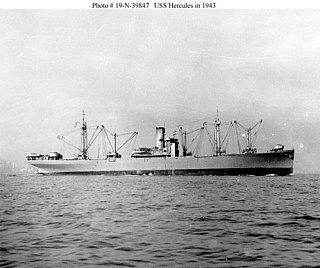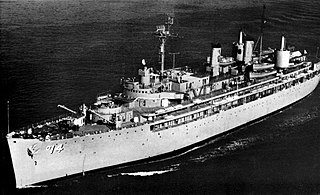The United States Navy, United States Coast Guard, and United States National Oceanic and Atmospheric Administration (NOAA) use a hull classification symbol to identify their ships by type and by individual ship within a type. The system is analogous to the pennant number system that the Royal Navy and other European and Commonwealth navies use.

The Mare Island Naval Shipyard was the first United States Navy base established on the Pacific Ocean and was in service 142 years from 1854 to 1996. It is located on Mare Island, 23 miles (37 km) northeast of San Francisco, in Vallejo, California. MINSY made a name for itself as the premier U.S. West Coast submarine port as well as serving as the controlling force in San Francisco Bay Area shipbuilding efforts during World War II.

High-speed transports were converted destroyers and destroyer escorts used in US Navy amphibious operations in World War II and afterward. They received the US Hull classification symbol APD; "AP" for transport and "D" for destroyer. In 1969, the remaining ships were reclassified as "Fast Amphibious Transports", hull symbol LPR.

Destroyer escort (DE) was the United States Navy mid-20th-century classification for a 20-knot warship designed with the endurance necessary to escort mid-ocean convoys of merchant marine ships.

The Clemson class was a series of 156 destroyers which served with the United States Navy from after World War I through World War II.

The Wickes-class destroyers were a class of 111 destroyers built by the United States Navy in 1917–19. Together with the six preceding Caldwell-class and following 156 subsequent Clemson-class destroyers, they were grouped as the "flush-deck" or "four-stack" type. Only a few were completed in time to serve in World War I, including USS Wickes, the lead ship of the class.

A destroyer tender or destroyer depot ship is a type of depot ship: an auxiliary ship designed to provide maintenance support to a flotilla of destroyers or other small warships. The use of this class has faded from its peak in the first half of the 20th century as the roles and weaponry of small combatants have evolved.

USS Frontier (AD-25) was one of four Klondike class destroyer tenders built at the tail end of World War II for the United States Navy.

The 3-inch/50-caliber gun in United States naval gun terminology indicates the gun fired a projectile 3 inches (76 mm) in diameter, and the barrel was 50 calibers long. Different guns of this caliber were used by the U.S. Navy and U.S. Coast Guard from 1900 through to 1990 on a variety of combatant and transport ship classes.

USS Klondike (AD-22/AR-22) was a destroyer tender in service the United States Navy from 1945 to 1970. In 1960, she was redesignated as a repair ship. After spending another five years in reserve, she was sold for scrap in 1975.

Type C3-class ships were the third type of cargo ship designed by the United States Maritime Commission (MARCOM) in the late 1930s. As it had done with the Type C1 ships and Type C2 ships, MARCOM circulated preliminary plans for comment. The design presented was not specific to any service or trade route, but was a general purpose ship that could be modified for specific uses. A total of 162 C3 ships were built from 1939 to 1946.

USS Arcadia was one of four Klondike-class destroyer tenders built at the tail end of World War II for the United States Navy, and the third U.S. Naval vessel to bear that name. Destroyer tenders were typically named after U.S. National Parks. However the destroyer tender AD-23 was apparently misnamed Arcadia in an effort to commemorate Acadia National Park in Maine.

USS Everglades (AD-24) was one of four Klondike class destroyer tenders built at the tail end of World War II for the United States Navy. The vessel was named for the Florida Everglades.

The Dixie class destroyer tender was a class of five United States Navy destroyer tenders used during World War II. This class's design was based on the specifications of USS Dixie (AD-14) and constructed based on drawings for that vessel plus ongoing modifications specified for each continued vessel of the class. The basic hull and superstructure for this class was the same as the Fulton-class submarine tenders and Vulcan-class repair ships.

The 3-inch/23-caliber gun was the standard anti-aircraft gun for United States destroyers through World War I and the 1920s. United States naval gun terminology indicates the gun fired a projectile 3 inches (76 mm) in diameter, and the barrel was 23 calibers long

The Shenandoah-class destroyer tenders were a class of destroyer tenders built for the United States Navy that served from 1945 to 1984.

The Altair class destroyer tender was a class of three United States Navy destroyer tenders. These ships were built in Skinner & Eddy's Seattle shipyard as commercial cargo ships during World War I, and acquired by the Navy when the shipyard closed in 1921. All three served through World War II, and were decommissioned and scrapped shortly after the war.

The designation of high endurance cutter (WHEC) was created in 1965 when the United States Coast Guard adopted its own designation system. High endurance cutters encompass the largest cutters previously designated by the United States Navy as gunboats, destroyer escorts, and seaplane tenders. The term High Endurance Cutter may refer to any of five individual ship classes that have seen service in the Coast Guard.
















